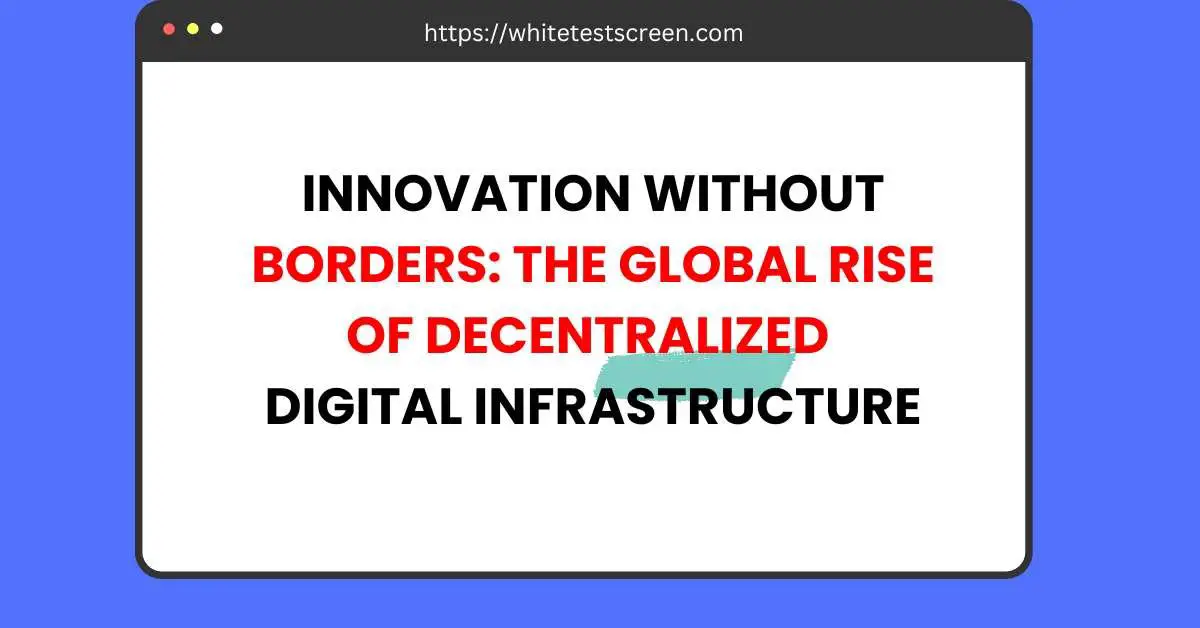
Innovation Without Borders: The Global Rise of Decentralized Digital Infrastructure
The way we use technology is changing fast. For a long time, big companies and governments controlled the internet, software, and data.
But now, a new kind of digital system is growing. One that is open, shared, and run by communities instead of a few powerful groups.
This is called decentralized digital infrastructure. From blockchain to peer-to-peer networks, people around the world, even in small towns and developing countries, are using these tools to solve problems and take control of their own data.
In this blog, we will explore how decentralization is reshaping innovation across the globe.
Rethinking the Foundations of Innovation
The global technology landscape is undergoing a fundamental shift. What was once controlled by centralized servers, proprietary software, and walled-off ecosystems is now giving way to decentralized, open-source, and community-driven digital infrastructures.
This transition isn’t only a technical evolution it reflects a broader social and cultural shift toward empowerment, transparency, and resilience.
Decentralized technologies like blockchain, distributed storage, and peer-to-peer protocols are laying the groundwork for a digital ecosystem that spans borders and defies traditional control structures. These innovations are not limited to high-tech startups in developed economies.
Instead, they are taking root in emerging markets, grassroots communities, and regions long underserved by the centralized internet.
Empowerment Through Accessible Tools
One of the most powerful aspects of decentralized infrastructure is its reliance on simple, inclusive tools that lower the barrier to entry for individuals and small businesses.
Whether you’re a street vendor in Nairobi or a teacher in rural Peru, the ability to engage with decentralized services can begin with something as practical as a QR code maker.
QR codes have become essential gateways to decentralized systems. They can link directly to crypto wallets, authenticate access to blockchain services, or verify credentials without the need for a centralized database.
Their versatility and ease of use make them particularly valuable in areas with limited internet access or where traditional identification systems are lacking.
Decentralization in Emerging Economies
Emerging economies are among the earliest and most enthusiastic adopters of decentralized infrastructure. This isn’t surprising many of these regions face longstanding challenges that centralized models have failed to resolve.
Financial inclusion, identity verification, and secure data storage are all issues that decentralized systems can address effectively and affordably.
In regions where trust in central authorities is low, decentralized alternatives provide a compelling proposition. They empower communities to own their data, verify transactions transparently, and interact with systems that cannot be manipulated by a single actor.
This trustless model is proving especially useful in sectors like microfinance, supply chain tracking, and peer-to-peer lending.
A Global Developer Movement
The rise of decentralized infrastructure has also ignited a global wave of developer participation. Unlike traditional tech industries that are concentrated in Silicon Valley or Western Europe, this movement thrives on open-source collaboration.
Developers from Lagos to Buenos Aires are building blockchain apps, decentralized autonomous organizations (DAOs), and distributed marketplaces that serve global audiences.
Open access to source code, documentation, and forums means that anyone with an internet connection can contribute to the next generation of digital infrastructure. This democratization of innovation is unlocking talent previously excluded from the global tech conversation.
Real-World Impact and Resilience
Decentralized systems are not just theoretical constructs they’re proving their value in real-world crises. In war-torn regions, censorship-heavy environments, or areas struck by natural disasters, decentralized platforms often remain operational when centralized ones fail.
Activists, humanitarian organizations, and civic groups are turning to decentralized messaging apps, storage platforms, and identity protocols to stay connected and protected.
These networks are inherently resilient because they distribute control across nodes. There is no single point of failure, making them difficult to shut down, censor, or corrupt. This robustness is critical in ensuring that essential services and freedoms remain accessible, regardless of geopolitical or infrastructural instability.
Challenges and the Path Forward
Despite its promise, decentralized infrastructure is not without challenges. Usability remains a significant barrier many decentralized apps (dApps) are still too complex for mainstream users. Regulation is another gray area, with governments struggling to classify and govern technologies that operate without a central entity.
Scalability and energy consumption, particularly for blockchain-based systems, are ongoing concerns. However, new consensus mechanisms and Layer 2 solutions are addressing these limitations, making decentralized systems more efficient and environmentally responsible.
The trajectory is clear: decentralized infrastructure is here to stay, and its influence will only grow. What was once a fringe movement is now powering global financial systems, creative platforms, governance tools, and more. By enabling participation from anyone, anywhere, decentralization is rewriting the rules of innovation.
This movement is more than technological, it’s cultural. It fosters values like collaboration, transparency, and local ownership.
As more people and communities tap into these systems, the digital world becomes less about control and more about connection, inclusion, and freedom.






